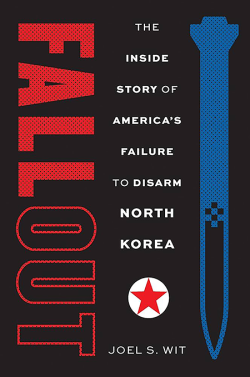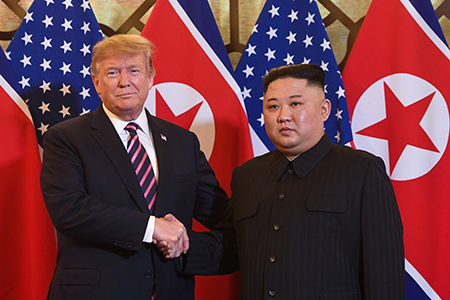Fallout
November 2025

Fallout
By Joel S. Wit
Yale University Press, 2025
Reviewed by Robert L. Gallucci
The U.S. Failure to Disarm North Korea
Joel Wit’s book is aimed at explaining how the United States could over three decades fail to prevent North Korea—one of the world’s poorest countries, regarded almost universally as a pariah nation with a population subject to intermittent famine and gross human rights abuses—from possessing a nuclear weapons arsenal, complete with intercontinental ballistic missiles. Even worse, that country would threaten to fire those weapons at the U.S. homeland and present a risk against which the United States can claim no confident defense and, plausibly, no sure deterrent.
In other words, how could the United States and its allies, South Korea and Japan, who are close neighbors to North Korea and armed with considerable military, economic, and political power, fail to dissuade the North from its destabilizing course?
To be fair, the book is about diplomacy and maybe the limits of diplomacy, at least for the United States. The author does not dwell on history, the awful catastrophe of the Korean War, or the reality of what a second Korean war would mean for South Korea, beginning with the modern city of Seoul, so close to the Demilitarized Zone and the artillery of the North. His book is about how the diplomacy of presidents Bill Clinton, George W. Bush, Barack Obama, and Donald Trump failed to protect the United States and its Asian allies from North Korea becoming a very personality-driven dictatorship armed with nuclear and thermonuclear weapons and their means of delivery.
One way of looking at the reality that is northeast Asia today is simply to recognize that North Korean leader Kim Il Sung, current leader Kim Jong Un’s grandfather, clearly saw nuclear weapons as essential to the survival of his country as early as the 1980s. At that time, the North’s ideological allies in China and the Soviet Union were slipping behind the United States, a rising superpower, and even behind South Korea, which was beginning to emulate Japan in becoming a world economy to be reckoned with.
One should not be surprised, then, that the North would have to carefully navigate its drive to become a nuclear-weapon state. It constantly and secretly worked to acquire the technical capability to do so while maintaining its commitment to non-nuclear-weapon status by joining the nuclear Nonproliferation Treaty and entering protracted negotiations with the United States. Those negotiations were aimed ostensibly at getting as much as Pyongyang could from Washington in payment for its commitment to abandon its nuclear weapons.
This is the backdrop to Wit’s detailed and fascinating narrative of U.S. diplomacy with North Korea over 30 years. In each administration, Wit identifies those who believed it was possible to “find a diplomatic solution” to the North Korean problem, and those whose skepticism was unbound. Understand, though, that this was no contest between realists and idealists—as much as those who doubted the plausibility of diplomatic success would have it be.
No one doubted the reality of the North Korean nuclear weapons program, which the South Korean and U.S. intelligence communities went to great lengths to expose in detail. The issue was whether it would be possible to craft a nuclear deal that would combine the essential elements of North Korean self-interest with the U.S. need to prevent another nuclear-weapon state from emerging—particularly one that would directly threaten the security of the United States and its northeast Asian allies. Any deal would have to address the threat as Washington thought Pyongyang perceived it, as well as economic and political improvements in the North’s condition.
Wit briefly explores the Clinton administration’s efforts, including the 1994 Agreed Framework, the visit to Pyongyang by U.S. Secretary of State Madeleine Albright and the failure to follow through on a planned visit to the capital by Clinton. But the author begins to go into depth with the bureaucratic battles of the Bush administration, of the secretary state at odds with the secretary of defense and the vice president, of Bush’s “axis of evil” speech, the transition at the State Department, and the start of six-party talks among China, Japan, North Korea, Russia, South Korea and the United States. The backdrop to all these in-house battles is the war in Iraq and the progress of North Korea’s nuclear weapons program, right up to its first nuclear explosive tests in 2006. At this point in the narrative, the reader can already appreciate what will become a hallmark of the book: its balance.
For those familiar with the history of U.S.-North Korea relations, it is hardly necessary to point out that Wit is not without his views on policy and the question of negotiators and hardliners: Wit was a player in this field and still is. Having said that, his balance throughout is remarkable. It is not surprising that his treatment of Stephen Bosworth, negotiator with North Korea during the Obama years, is positive, even warmly affectionate as it is, and rightly so. Similarly, his characterization of the efforts of Bosworth’s predecessor, Chris Hill, as virtually herculean is appropriate, albeit expected because Wit worked with Hill.
What is surprising is the author’s approach to those who were deeply suspicious of efforts to engage the North Koreans diplomatically. It is not unusual for officials to worry that such an initiative could squander precious presidential credibility on a hopeless goal. The intelligence community and State Department officials Danny Russel and Kurt Campbell, among many others in the Obama administration who were at least skeptical of the likely success of diplomatic engagement with the North, are treated with respect and their importance in shaping policy is acknowledged. This is rare and should be appreciated.

That said, in Wit’s telling, the Obama years were deeply disappointing. From the beginning, the president made known his view that negotiating with an adversary should not be seen as a reward, and that the key condition was the careful preparation that would be essential to success. The administration’s inauspicious start made the execution all the more painful as the 2012 leap day deal with North Korea fell apart. As Wit writes, “In fact, the Obama administration had decided to deal with North Korea by not dealing with North Korea.” The decision to abandon even the pretense of seeking a diplomatic solution was captured by the phrase “strategic patience” to characterize the non-policy. It became clear to everyone that the administration was moving on to deal with Iran, where the president and his team would seek and achieve a diplomatic success.
Half of the book is taken up with the Bush and Obama administrations’ 16 years of efforts to stop the North Korean nuclear weapons program. The other half is devoted to the Trump administration’s four years aimed at the same objective. What had changed by the time Obama sat down with President-elect Trump at the White House in 2017 was the North Korean nuclear weapons program. The expanding number and sophistication of nuclear weapons and delivery vehicles and the extent to which the North could put the United States at risk of losing its superpower status would soon be at the point where the United States could do virtually nothing about it.
Whether the new president understood this is unclear. Some comments made by Trump suggest that he had an inflated sense of the effectiveness of U.S. ballistic missile defense capability against attacking ICBMs. In the years since then, the North plausibly has tested a thermonuclear weapon, produced a more advanced version of its intercontinental delivery vehicle, and tested shorter range ballistic missiles. But during the Trump presidency, the United States engaged the North in a way it had never done before: directly at the presidential level, on three occasions.
Wit gives Trump credit for personally taking on an issue of overriding national security significance. It is arguable, by the author’s account, that if Clinton, Bush, or Obama had done the same thing, the United States might be better off today. But Trump’s engagement also left much to be desired. Notwithstanding the designation of the very capable Deputy Secretary of State Stephen Biegun to be in charge of North Korea negotiations, the kind of carefully prepared summits that Obama had envisioned would not prove to be consistent with Trump’s style. Indeed, the last of his meetings with North Korean leader Kim Jong Un proved to be be a disaster.
In retrospect, the idea that that last meeting in Hanoi—where the principals “met for lunch,”—would finally reach a breakthrough on North Korea’s refusal to abandon its nuclear weapons sounds absurd. Only the U.S. national security advisor, John Bolton, who was opposed to this or any other meeting with the North Koreans, was pleased with the way it ended. Trump was disappointed when he left and Kim was furious.
There followed another Democratic administration, headed by President Joe Biden, when nothing much was expected to happen on the North Korean front and nothing much did. However, Trump, from the start of his second term in office this year, has given reason to believe he will reach out again to Kim and renew their relationship.
Indeed, Kim has indicated recently that he would be happy to re-engage, as long as the United States does not pursue denuclearization again or improved relations between North and South Korea. Busy as Trump is in pursuing objectives in the Middle East, Ukraine, and Latin America, he arguably does have a comparative advantage in northeast Asia, where his personal diplomacy with Kim brought him more success than his predecessors. A word of caution, however, may nevertheless be appropriate.
Adopting an opening posture that does not insist on denuclearization would seem prudent now, but abandoning denuclearization as a goal, even a long-term goal, would indeed be imprudent. The United States still has a continuing interest in resisting the spread of nuclear weapons to additional countries, and in persuading states that have acquired nuclear weapons since the NPT came into force to freeze their programs, at least until reversal becomes politically plausible. With respect to North Korea, the least that can be said is that the world looks forward to the day when the Korean peninsula can become nuclear-weapons-free and united. To say less is to encourage more intense conversations in South Korea and Japan about the durability of their countries’ non-nuclear statuses, which is in no one’s interest.
Anyone who is interested in security in northeast Asia should not miss this book. The same is true for anyone interested in U.S. foreign policy, how it is made, and the way those who make it think about the nation’s interest. Wit is keenly aware of how wrongheaded U.S. policy can be even when very smart, well-meaning, experienced experts guide it. He does not shrink from pointing out how that applies to U.S. policy on North Korea. He has known the people, senior and junior, who have been important to this policy over the last three decades and he has treated them fairly and honestly. The book is a great service to the public record on North Korea and the men and women who shaped U.S. policy.
